#especially combined with life extension and robotics/ai
Explore tagged Tumblr posts
Note
What do you think about decreasing fertility rates and population decline? Should we be concerned? What is your solution?
i am very concerned. think it is potentially the greatest existential threat facing human civilization, especially alongside climate change. imagine populations collapsing, then civilization collapsing with it (due to all the pressures caused by a population collapse), then having a bunch of anarchic primitive societies trying to cope with climate change without the benefit of all our modern technologies (and that includes things like farming -- how many people actually know how to farm? and even more, how many people know how to farm without modern technology?).
with that said, i'm a futurist and an optimist. i believe we will overcome this hurdle like we've overcome all others.
as for what i believe to be possible solutions...
universal basic income is a start. more parental leave. reduce work hours and more remote work for a better work-home life balance. higher wages. affordable high quality daycare. family-oriented education and /actual/ family planning centers where they offer resources and info for having big families. educate people on why having kids is good, for individuals and society, and emphasize the risks of not having kids. fund movies and shows and books which are pro-family, pro-humanity, and pro-natalist. want movies that celebrate family and having kids and demonize people who are childless. being childless needs to be seen as cringe and only for losers. we need to change the culture generally. including in the education system and celebrities and the highest levels of academia. we need to be pushing pro-natalism. we need to encourage an optimistic, life-affirming national ideology through all of the institutions. also just education reform in general. make higher education great again, rather than just the "next step" after high school. and make it free for the truly qualified. and offer career education in other forms.
build walkable, family-friendly cities with more affordable housing. universal healthcare. financial incentives like tax credits per child or family loans for married couples where a portion of the loan is paid off for each child or even preferential loans for homes for extended families or something. meanwhile tax childlessness. invest in automation of menial jobs so we can increase wages and reduce work week. invest in robotics so we can have robot-servants who help reduce the burden of household chores and childcare. invest in artificial exowombs. invest in life extension technologies. encourage people to freeze sperm, eggs, zygotes. encourage space exploration and colonization. address climate change (for a multitude of interrelated reasons, not least of which is because many anti-natalists use it as justification for their death cult).
again, just generally speaking, we need to encourage an optimistic, life-affirming ideology. we need to show people that a better world -- one filled with hope, vitality, nobility, beauty -- is possible.
and, of course, join my cult (which encourages having children).
basically all americans should live as if they were the aristocrats of the globe. living lives of ease and luxury where they are free to hone their skills and virtue and raise future generations of world-aristocrats.
and we need to understand that degrowth, anti-natalist types aren't actually interested in saving the world like they pretend. they are anti-human, life-hating demons who are members of a death cult. they are the ugly and vicious enemies of goodness.
#many people think just allowing more immigration is the solution#but it's not#it's a very short term bandaid because dropping birthrates is an issue around the globe#better to invest in self-sufficiency rather than relying on a dwindling foreign source#it's basically natalist offshoring#not to mention all of the other negative externalities that come with mass immigration#but with that said#i am confident even if we go with a managed decline#and focus on a small but high quality population#we'll be okay#especially combined with life extension and robotics/ai
2 notes
·
View notes
Text
Trends and Forecasts in the Second Life Industrial Robot Market

The Second Life Industrial Robot MarketSecond Life Industrial Robot Market is rapidly expanding as businesses increasingly seek cost-effective automation solutions across manufacturing, logistics, and automotive sectors. These pre-owned, refurbished robots offer a budget-friendly alternative to new systems while delivering reliable performance and extended lifecycles. Growing trends include advanced refurbishing services, AI integration, and alignment with Industry 4.0 technologies, enhancing robot adaptability and efficiency. Despite challenges like standardization gaps, compatibility issues, and skilled labor shortages, the market benefits from rising demand driven by cost optimization and sustainability efforts. With ongoing innovations and a focus on circular economy practices, the second-life robot market is poised for significant growth and greater adoption worldwide.
Market Segmentation:
1. By End Use:
Industrial
Waste Recycling
Others
2. By Type of Refurbishment:
New Controller Technology
Others
3. By Region:
North America
Europe
Asia-Pacific
Rest of the World
Key Market Players
ABB
FANUC
IRS Robotics
Key Demand Drivers
Inexpensive Automation for Small and Medium Businesses: Because second-life robots drastically lower startup costs, automation is now affordable for manufacturers on a budget as well as small and mid-sized businesses (SMEs). This affordability is especially alluring in budget-conscious competitive industries and growing markets.
Goals for the Circular Economy and Sustainability: Businesses are adopting sustainable practices as a result of increased environmental awareness and more stringent e-waste rules. In line with circular economy concepts, refurbished robots prolong the useful life of current gear while lowering the load on landfills and conserving vital resources.
Improvements in Technology: Refurbished robots are becoming more versatile thanks to improved controller systems, AI integration, and machine learning applications. These improvements make older models more useful in high-precision settings and smart factories by enabling them to function on par with machines of the latest generation.
Market Challenges
Absence of Standardized Procedures for Renovation: Variations in robot safety, dependability, and quality caused by inconsistent refurbishing procedures among vendors may worry end users and restrict further adoption.
Integration Difficulties: Connecting legacy systems to automation platforms, Industry 4.0 frameworks, or contemporary software environments may necessitate extensive adaptation. Potential customers may be turned off by these integration fees, which can cancel out any initial savings.
Lack of Skilled Workers: Industrial robot maintenance and repair require specialized technical knowledge. The consistency of refurbished equipment quality and the scalability of services can be affected by a shortage of qualified personnel.
Get your hands on this Sample Report to stay up-to-date on the latest developments in the Second Life Industrial Robot Market.
Gain deep information on Robotics and Automation Market. Click Here!
Future Outlook
Through 2030, the market for used industrial robots is anticipated to develop significantly due to the combined demands of sustainability and economic efficiency. The performance of reconditioned robots will continue to improve with the development of AI-enabled control systems and modular modifications, making them more and more feasible for high-end industrial applications. With the help of favorable government policies, growing SME automation, and fast industrialization, the Asia-Pacific area is expected to grow at the fastest rate. Because of its well-established robotics infrastructure and advanced refurbishing skills, North America is expected to continue to hold its dominant position.
Conclusion
With its perfect blend of cost, sustainability, and performance, the second life industrial robot market is becoming a vital part of the worldwide automation scene. Refurbished robots are turning out to be a valuable asset for contemporary industry as the need for intelligent, environmentally friendly, and scalable automation solutions increases. Even if there are still issues with standardization and integration today, industry cooperation, technical advancement, and training programs should help to lessen them over time. The market for second-life robots is positioned for long-term growth and change because to strong regional demand and growing environmental concern.
#Second Life Industrial Robot Market#Second Life Industrial Robot Industry#Second Life Industrial Robot Report#robotics#automation
0 notes
Text
Your Digital Twin Awaits: Make Stunning 3D Video Avatars
Have you ever imagined having a digital version of yourself powered by 3d avatar creation software, speaking, interacting, and even expressing emotions like a human? With the surge in Agentic AI avatars, the era of hyper-personalized virtual presence is not just coming — it’s already here. Whether you’re looking to create lifelike characters, anime-inspired personas, or business-ready digital reps, today’s tools like 3d anime avatar creator and ai avatar video creator are making it remarkably accessible.

Why 3D Avatars Are More Than Just a Trend
I remember the first time I saw a realistic 3D avatar delivering a product demo — it didn’t just talk, it connected. That’s the power of modern ai avatar technology. What used to be clunky, robotic avatars are now expressive, human-like entities driven by realistic conversation AI agents and Agentic AI capabilities.
From influencers and educators to gamers and businesses, 3D avatars serve as digital extensions of ourselves. With tools like 3d avatar creator online and 3d avatar maker online, anyone — no coding skills required — can build a full-blown virtual personality.
The Technology Behind Your Digital Twin
So, how exactly does this digital twin come to life?
At the heart of it is 3d avatar creation software that blends facial tracking, motion capture, AI voice synthesis, and character modeling. Combine that with avatar ai video generator capabilities, and you’re not just looking at a static model — you get a speaking, blinking, emotionally expressive avatar.
Here’s how it all works:
3d avatar creation software: Designs the look of your avatar, from hair color to facial structure.
3d anime avatar creator: Adds stylistic flair, perfect for streamers, influencers, and virtual YouTubers.
ai video avatar generator: Creates a seamless video experience of your avatar speaking in real time.
realistic conversation ai agents: Enable lifelike interactions with real-time responsiveness and emotional range.
Applications Across Industries
What’s truly exciting is how diverse the use cases are:
1. Content Creators & Influencers

2. Corporate Training & Sales
Companies are now hiring Realistic Multimodal Agents to act as virtual trainers or digital sales reps. These agents can carry out onboarding, product pitches, and customer support without ever clocking out.
3. Gaming & Metaverse
The demand for stylized yet interactive avatars is booming. Enter the 3d anime avatar creator, where users can step into digital realms with expressive, agile characters representing them.
4. Healthcare & Therapy
Believe it or not, realistic conversation ai agents are being used in mental health applications to simulate conversations, provide support, and assist in therapies — especially when human counselors aren’t readily available.
The Rise of Agentic AI and Multimodal Intelligence
Let’s talk about the two forces fueling this revolution: Agentic AI and Realistic Multimodal Agents.
Agentic AI avatars aren’t just programmable; they’re proactive. These digital entities can initiate conversation, learn from interactions, and simulate independent reasoning. They’re no longer passive responses to inputs — they’re active participants.
Meanwhile, Realistic Multimodal Agents services integrate vision, language, tone, and gestures. This multimodal capability makes your avatar not just speak — but connect, convince, and empathize. You’re not just creating a video. You’re crafting a personality.
How to Get Started with Your Own AI Avatar
Creating a 3D avatar used to sound like something only Pixar or high-end gaming studios could do. Not anymore.
Here’s a basic roadmap:
Design your avatar using a 3d avatar maker online or 3d avatar creator online. Choose from templates or customize every detail.
Add voice and motion using an ai video avatar generator. These platforms allow you to upload scripts, select voice tones, or even use your own.
Enable real-time interactivity with realistic conversation ai agents, letting your avatar respond dynamically to live questions.
Deploy it — on your website, in training modules, on YouTube, or even inside a metaverse platform.
For anime lovers or creators targeting Gen Z audiences, the 3d anime avatar creator gives you that stylized, eye-catching flair that makes content pop.
My Personal Experience: Seeing Myself as a Digital Twin
On a whim, I tried a 3d avatar creator online just to see what I’d look like in digital form. Within 30 minutes, I had a surprisingly accurate avatar — not only with my features but also my voice. Using an ai avatar video creator, I created a 2-minute clip of “me” talking about a new product line. The reactions I got? “Whoa, that’s so real!” and “Wait, that’s not actually you?”

Why Now Is the Time to Go Digital
The convergence of Agentic AI, ai avatar video creator tools, and Realistic Multimodal Agents makes 2025 the tipping point for 3D digital humans. Whether you’re a startup trying to stand out or a brand aiming to reduce costs and boost engagement, your ai avatar can do the talking — for real.
And with platforms offering easy-to-use 3d avatar creation software and avatar video ai generator tools, there’s no barrier anymore. Just imagination.
Conclusion: Your Digital Twin Is Just the Beginning
Creating a digital twin is not about replacing yourself — it’s about expanding your presence. With tools like 3d avatar maker online, avatar ai video generator, and Realistic Multimodal Agents services, your avatar becomes a 24/7 version of you — always ready to engage, explain, and entertain.
The world is going digital, and it’s not waiting.
1 note
·
View note
Text
Best Smart Cleaning Devices for Luxury Apartments in Kochi
In the modern, fast-paced world, maintaining a clean home, especially in luxury apartments in Kochi, can appear to be a herculean task. The need to balance work, family, and personal life often leaves little time for extensive cleaning routines. Fortunately, technological innovations have come to the rescue, presenting a range of smart devices that convert laborious work into smooth, nearly automated activities. This evolution in cleaning practices is not just about convenience; it is also about saving valuable time and creating a healthier, more comfortable living space.
Hands-Free Cleaning with Robotic Vacuum Cleaners The introduction of robotic vacuum cleaners has transformed the process of maintaining clean floors. These compact yet powerful devices navigate around furniture, detect obstacles, and clean every corner with minimal human assistance. Advanced models are equipped with AI mapping technology, which enables them to memorize the layout of your home for optimized cleaning routes. With features for scheduled cleaning, these devices can keep your floors clean even when you are not at home. Whether it’s pet hair, dust, or crumbs, robotic vacuum cleaners provide an effortless cleaning solution, allowing you to conserve time and energy.
Smart Mops for a Deeper Clean Those desiring a more intensive cleaning solution will find smart mops as a valuable addition to their cleaning toolkit. Unlike traditional mops that require scrubbing and wringing, these technologically advanced devices utilize precise water spraying, vibrating pads, or rotating mop heads to efficiently remove dirt and stains. Some variants even offer a combination of vacuuming and mopping, allowing for a complete cleaning process in a single effort. With features like automatic docking and self-cleaning pads, these mops reduce the effort required while ensuring a high standard of cleanliness, making them an excellent choice for households with a hectic lifestyle.
Crystal-Clear Views with Automated Window Cleaning Cleaning windows in high-rise apartments or large homes can be both time-consuming and risky. Automated window cleaners have effectively addressed this issue by providing a hands-free solution for achieving sparkling glass surfaces. These devices utilize suction technology to securely grip windows and move in a systematic manner, effectively removing dirt, smudges, and streaks. Smart window cleaning devices, equipped with AI sensors, are designed to recognize edges, prevent falls, and adjust their cleaning routes for superior efficiency. With remote access and pre-configured cleaning modes, they provide an easy and effective way to keep windows clean throughout the year.
Breathe Easier with Smart Air Purifiers A clean home is not only about what is visible; the air quality is equally important for maintaining a healthy living space. Smart air purifiers can remove dust, allergens, pet dander, and pollutants, contributing to a more refreshing indoor atmosphere. These devices are particularly useful for individuals with respiratory issues or allergies. Modern air purifiers are designed with real-time air quality monitoring, which allows for automatic adjustments to filtration levels in response to detected pollutants. Many of these models can connect to smartphone applications, giving users the ability to monitor air quality trends and adjust settings remotely. By providing clean and breathable air, these smart devices contribute to a healthier and more comfortable living space.
Conclusion The introduction of smart cleaning devices has revolutionized home maintenance, offering extraordinary convenience, efficiency, and cleanliness. From vacuuming and mopping to window cleaning and air purification, these intelligent devices greatly reduce the time and effort needed to maintain a spotless home. As one of the best builders in Kochi, Kent Constructions acknowledges the importance of contemporary lifestyles and is committed to integrating the finest technology to design homes that are both visually appealing and easy to maintain.
#4 bhk flats in kerala#premium flats in kochi#4 bhk apartments in kochi#best apartments in edappally
0 notes
Text
How Tech Transforms Diagnosis & Care
Modern healthcare is experiencing a period of rapid change, propelled by technological advancements that are reshaping how medical professionals diagnose and treat various conditions. Today, practitioners benefit from a range of powerful tools—such as artificial intelligence (AI) platforms, genomic testing services, robotic surgical systems, and extensive telemedicine networks—that were almost unthinkable just a few decades ago. These innovations do more than streamline administrative tasks or speed up lab results; they redefine the fundamental process of understanding diseases and guiding patients toward improved health outcomes.
Several factors fuel this transformation. A global push for faster, more precise medical interventions has led researchers and clinicians to explore data-driven solutions, resulting in breakthroughs that improve diagnostic accuracy. Concurrently, the demand for personalized care drives the development of treatments that cater to each patient’s genetic makeup, lifestyle, and specific health challenges. Furthermore, increasing connectivity in both urban and rural areas now makes advanced healthcare services more broadly available, reducing treatment disparities and expanding patient access. As you read on, consider how the following four areas—AI-enabled diagnostics, genomics, robotic-assisted procedures, and telemedicine—are redefining core aspects of modern healthcare. By examining each topic, you will discover how these technologies enhance the quality of medical care, from routine check-ups to life-changing therapies.
AI-Driven Diagnostics for Early Detection
Artificial intelligence (AI) has quickly become a vital resource for improving the speed and accuracy of disease detection. At its core, AI involves training computer algorithms to recognize patterns in data, a task especially useful when dealing with extensive medical records, lab results, and imaging scans. Traditional diagnostic processes may require separate specialists to review patient histories, radiologic images, and symptom reports. With AI, health professionals gain an extra layer of analytical power that sifts through information in seconds, identifying subtle indicators that even seasoned clinicians might overlook.
One noteworthy area where AI excels is medical imaging analysis. By comparing new scans against vast libraries of existing images, machine learning models can isolate slight abnormalities or early signs of diseases such as lung cancer or diabetic retinopathy. These predictive capabilities enable physicians to catch conditions at a stage when they are often more treatable. For instance, by detecting minimal nodules or microaneurysms, AI systems can prompt clinicians to plan timely follow-up tests or specialized interventions. This early detection approach decreases the likelihood of complications, ultimately saving time, healthcare resources, and—most importantly—lives.
Additionally, AI supports chronic disease management in significant ways. Tools built around predictive analytics can signal impending flare-ups in conditions like heart failure, asthma, or diabetes by monitoring vital signs and daily health metrics. When combined with wearable devices that transmit real-time information, AI-driven systems offer continuous supervision that can help patients avoid acute episodes, hospital readmissions, or lengthy ER visits. Despite concerns about data privacy and the importance of clinical oversight, many experts believe that AI’s diagnostic potential far outweighs its challenges, as long as robust safeguards and regulatory frameworks remain in place.
Genomics and Personalized Treatment Approaches
While AI refines how physicians detect and categorize illnesses, the field of genomics transforms medical care at a more fundamental level—within our DNA. Genomics focuses on understanding an individual’s genetic blueprint to identify disease risk factors and recommend therapies that match specific mutations or inherited traits. The cost of genome sequencing has plummeted in recent years, enabling more clinics and research centers to integrate genetic tests into regular patient assessments. This progress has significant implications for disorders such as hereditary cancers, autoimmune diseases, and familial hypercholesterolemia, among others.
One result of genomics research is the evolution of precision medicine. Rather than using generalized treatments, healthcare providers can target interventions to the precise nature of a patient’s illness. Oncology offers clear examples of this approach. Certain targeted drugs address cancers driven by distinct genetic mutations, so patients who test positive for those mutations tend to respond more favorably to specialized treatments. By focusing on the underlying biology, oncologists can reduce adverse reactions commonly associated with broad-spectrum chemotherapy, creating a more tolerable and effective experience for the patient.
Genomics also aids in prevention. When physicians identify genetic predispositions—such as BRCA1 or BRCA2 for breast and ovarian cancers—they can recommend earlier and more frequent screening, significantly improving the odds of catching abnormalities in initial stages. Furthermore, genetic counselors guide individuals in understanding their inherent risks, reinforcing the importance of lifestyle modifications or prophylactic measures. While ethical, social, and economic questions persist—particularly regarding genetic data privacy and equitable access—the promise of genomics remains immense. As more people benefit from personalized care and fewer side effects, genomic medicine is steadily becoming a cornerstone of modern healthcare.
Robotic-Assisted Procedures and Minimally Invasive Options
Parallel to advancements in diagnostics, treatment methods continue to evolve. Robotic-assisted surgery has introduced new levels of precision and control in the operating room. Systems such as the da Vinci Surgical System equip surgeons with robotic arms that translate hand motions into finely tuned movements. High-resolution cameras and 3D displays grant a detailed view of the surgical site, allowing clinicians to maneuver around delicate tissues with greater confidence. This level of surgical accuracy frequently leads to smaller incisions, minimized bleeding, and faster postoperative recovery compared to traditional open surgeries.
Outside the OR, robotics play an equally transformative role. Physical rehabilitation, for example, benefits from technology that supports patients learning to walk after strokes or spinal cord injuries. Robotic exoskeletons deliver programmed resistance and track progress, letting therapists adjust routines in real time. This personalized feedback enhances results, helping individuals regain mobility more quickly and effectively. Meanwhile, automated systems in hospital pharmacies help minimize medication errors, ensuring patients receive accurate dosages while freeing medical staff to focus on direct patient care.
These robotic tools do present some obstacles, mainly cost and training. Specialized equipment can be expensive for smaller institutions, and surgical teams must learn how to operate the robotic interfaces proficiently. Nonetheless, the overall trend suggests that robotic-assisted techniques will continue to spread as the field refines. This shift helps maintain clinical consistency, especially in procedures requiring sustained steadiness or repeated tasks. Patients facing major operations increasingly inquire about robotic capabilities, attracted by the promise of less pain and a quicker path to daily activities.
Telemedicine and Remote Monitoring for Greater Access
Technological breakthroughs are not limited to hospital labs or operating rooms. Another important innovation is telemedicine, which connects clinicians and patients across distances. By using secure video conferencing and digital health platforms, healthcare providers deliver consultations, manage follow-ups, and offer basic diagnoses without requiring travel. This aspect of remote care has been particularly helpful for individuals living in rural or underserved regions, where specialist visits may otherwise require hours-long journeys. Moreover, telemedicine extends specialist care to places like nursing homes or rehabilitation centers, where mobility constraints can hamper timely in-person appointments.
Remote monitoring devices also boost diagnostic and treatment capabilities. Wearable sensors measure vital signs, track physical activity, and upload patient data to health portals that clinicians can analyze at any time. In this scenario, healthcare professionals can identify warning signals for chronic conditions—like a spike in blood pressure or an irregular heartbeat—before a patient even notices a symptom. Early intervention often prevents complications that might lead to hospital admissions or long-term damage. For example, individuals with congestive heart failure can adopt telemonitoring programs that keep tabs on weight changes and oxygen saturation, helping providers adjust medications or advise dietary modifications promptly.
While telemedicine offers convenience and cost savings, it relies on reliable internet infrastructure and a degree of digital literacy among users. Some worry about data security and confidentiality in virtual platforms. Nonetheless, these concerns are balanced by the numerous benefits, including expanded access to experts, reduced travel, and heightened engagement in personal health. Over time, as connectivity improves globally, telemedicine and remote patient monitoring will likely play an even more prominent role in bridging the care gap, ensuring that leading-edge diagnostic tools are available to a broader segment of the population.
From artificial intelligence that interprets subtle images to genomics that reveals hidden vulnerabilities in our DNA, medical technology has truly transformed the landscape of diagnosis and treatment. These advancements have unlocked faster, more targeted methods for detecting conditions and customizing interventions. At the same time, robotic systems in the operating room and remote monitoring solutions in patients’ homes reflect how each step of the care continuum is becoming more responsive, efficient, and attuned to individual needs.
Despite the promise, this technology-driven revolution brings challenges such as cost, data security, and training requirements. Not all communities can immediately adopt advanced machinery or incorporate telemedicine at a meaningful scale. Ethical questions concerning AI’s decision-making autonomy or the boundaries of gene editing must also be addressed to ensure ethical and inclusive progress. Nevertheless, the overarching trend in healthcare remains clear: as tools become more capable, clinicians and patients alike benefit from precise, data-driven approaches that streamline care and elevate outcomes. Whether one is considering early detection, specialized surgeries, or personalized genomic therapies, the integration of modern technology continues to expand the frontiers of what is medically possible, fostering hope for a future where diagnoses are more accurate, treatments are more effective, and access to care is universally improved.
0 notes
Text
Automation in Cars Redefining Mobility Beyond Human Control
The automotive industry is undergoing a revolutionary shift with the emergence of autonomous vehicles (AVs). This transformation marks the transition from traditional cars to self-driving vehicles with minimal to zero human intervention. From ride-hailing services to logistics and public transportation, self-driving cars are set to redefine the future of mobility.
Several critical technologies are at the core of self-driving cars. For instance, a combination of LiDAR, radar, ultrasonic sensors, and cameras forms the backbone of vehicle awareness systems. In this regard, Minus Zero, an AI startup, introduced its zPod concept vehicle in June 2023. It incorporates a camera-sensor suite and uses Nature Inspired AI (NIA) and True Vision Autonomy (TVA) to simulate human-like perception and decision-making in real time. Such advancements illustrate the potential of integrating multiple sensor technologies with innovative AI models.

How does AI enhance self-driving cars?
Advanced AI models, such as those implemented by Tesla’s Full-Self Driving mode or Waymo’s autonomous systems, enable AI decision-making in cars, allowing vehicles to interpret road situations and react accordingly. An excellent example of AI integration is Tesla’s Project Dojo. This project focuses on managing extensive video data from Tesla vehicles, which is critical for refining its autonomous driving software.
What is Vehicle-to-Everything (V2X) Communication?
This term encompasses vehicle-to-vehicle (V2V) and vehicle-to-infrastructure (V2I) connectivity. These communication systems are essential for coordinated driving and route planning. V2X technology allows self-driving cars to exchange information with other vehicles and road infrastructure, which improves safety and efficiency. For instance, in August 2023, Baidu expanded its autonomous ride-hailing platform Apollo Go to Wuhan Tianhe International Airport. This deployment leverages V2X communication to ensure safe and efficient interactions between autonomous cars and the airport’s infrastructure.
Challenges Faced by Self-driving Cars
The road to full automation is not without obstacles, and several challenges need to be addressed to achieve the seamless integration of autonomous vehicles into daily life.
Technical Challenges:
One of the most significant hurdles for autonomous vehicles is handling complex driving scenarios. Inclement weather conditions, unexpected movements from pedestrians, and poorly maintained roads can pose difficulties for AI systems, often leading to errors in decision-making. To address this, Kodiak Robotics, a prominent autonomous trucking company, joined the CVSA Enhanced Commercial Motor Vehicle (CMV) Inspection Standard program. This initiative allows autonomous trucks to undergo pre-clearance for roadside inspections, enhancing the safety and reliability of self-driving trucks on public roads.
Regulation and Legislation:
Autonomous vehicle regulation remains a key challenge for its widespread adoption, as laws governing self-driving cars vary across different regions. These differences in regulations create fragmented legal scenarios, impacting the deployment of self-driving technology.
In September 2023, California Governor Gavin Newsom vetoed a bill that sought to mandate human drivers in self-driving trucks weighing over 10,000 pounds. This decision triggered debates around job security and safety within the autonomous trucking sector, highlighting the conflicting priorities between advancing automation and protecting the interests of workers in the industry.
Contrastingly, in July 2021, Germany took a more proactive approach by allowing driverless vehicles equipped with Level 4 automation to operate within designated zones under the condition of technical supervision.
Ethical Concerns in Autonomous Vehicles:
The deployment of AI decision-making in cars introduces complex ethical dilemmas, especially when it comes to handling life-and-death scenarios. Suppose an autonomous vehicle faces a situation where it must choose between two harmful outcomes; the programmed decision-making protocols come under ethical scrutiny. Additionally, the extensive data collection by self-driving cars raises concerns about privacy in autonomous vehicles, as passengers and their journeys are constantly monitored. Despite these ethical concerns, several companies are spearheading the development of self-driving cars.
Notable Advancements regarding Automation in Cars
Several companies are spearheading the development of self-driving cars, from traditional automakers to tech giants. Their diverse approaches reflect the growing competition and collaboration within the industry.
In July 2023, Volkswagen Group of America launched a program to test autonomous vehicles in Austin, Texas. This initiative began with 10 all-electric ID Buzz vehicles with a goal to roll out self-driving ride-hailing and delivery services by 2026.
In October 2023, Uber partnered with Waymo to integrate Waymo’s autonomous vehicles into its ride-hailing service in Phoenix, offering customers autonomous rides at standard Uber rates.
Apple revised its self-driving goals in December 2022, delaying the launch of its autonomous electric vehicle by a year to 2026.
In December 2022, Baidu received authorization to conduct AV trials on public roads without a human safety operator inside the vehicle, marking a milestone in the industry.
Vehicle Automation: Levels of Autonomy
To classify the varying stages of automation, the Society of Automotive Engineers (SAE) introduced a six-level framework.
Level 0: No automation – A human driver entirely controls the vehicle. While some autonomous vehicle safety features like collision warning or stability control exist, they only offer brief interventions rather than taking over driving tasks.
Level 1: Driver assistance – At this stage, the vehicle can be assisted with a single task, such as steering or accelerating, but the driver must remain engaged.
Level 2: Partial automation – Here, vehicles can handle multiple tasks like steering and braking simultaneously; however, the driver must continuously monitor the system. It enables limited hands-free driving on approved highways but still requires active human supervision.
Level 3: Conditional driving automation – Vehicles at this level can take full control under specific conditions, but a human driver must be ready to intervene. Honda introduced a Level 3 system in 2021 for the Japanese market, becoming the first automaker to offer such a system.
Level 4: High driving automation – These vehicles can operate without human input within designated areas using geofencing technology. Level 4 automation is being tested for robotaxi services and autonomous public transport.
Level 5: Full driving automation – The ultimate goal of automation, Level 5 systems can operate under any conditions without human intervention. These vehicles are not limited by geofencing or specific conditions, allowing for a complete transformation of private and shared transportation.
Future of Autonomous Vehicles
The rise of robotaxi services and autonomous public transport aims to tackle challenges like traffic congestion and environmental sustainability. With projections indicating over 2 billion cars on the road by 2050, shared autonomous transport could mitigate the adverse effects of a growing vehicle population. Volkswagen’s collaboration with Mobileye, set to launch a robotaxi service by 2025, is a step toward this goal. However, to support the widespread use of autonomous vehicles, cities must invest in smart infrastructure with autonomous-friendly road designs and digital mapping systems. The future of autonomation in cars envisions a seamless integration of smart infrastructure, AI, IoT, and automated vehicles working harmoniously.
#automation#selfdrivingcars#autonomousvehicles#autonomouscars#automobileindustry#mobility#marketoverview#tritonmarketresearch
0 notes
Text
Organichaptar Organic Human or robotic natural life style futures generations scientific technology
The future of organic robotics, also referred to as "Organichaptar," integrates principles of organic chemistry with robotics to create systems that closely mimic or integrate with biological organisms.
This concept can be applied to various domains, each with its implications for human mindsets and future possibilities. Here are several types and their potential impacts:
Biohybrid Robots:
Definition: Robots that combine biological tissues with synthetic components.
Potential: These robots could perform delicate tasks in medical procedures, environmental monitoring, and more.
They might be capable of self-healing or adapting to their environment.
Impact on Mindset: Shifts towards viewing robotics as extensions of the natural world rather than purely mechanical entities.
Soft Robotics:
Definition: Robots made from flexible materials that can mimic the movements of living organisms.
Potential: Improved interaction with humans, safer for delicate tasks, and adaptable to various environments.
Impact on Mindset: Enhanced comfort and trust in robotic systems, especially in healthcare and daily life applications.
Biodegradable Robots:
Definition: Robots made from biodegradable materials that can break down naturally after use.
Potential: Reduced environmental impact, temporary medical implants, and eco-friendly disposal.
Impact on Mindset: Promotes sustainability and environmental consciousness in technology development.
Organic Computing:
Definition: Computing systems inspired by or incorporating organic processes.
Potential: More efficient and adaptive computing systems, potentially leading to breakthroughs in AI and machine learning.
Impact on Mindset: Redefines the boundaries between biological and digital realms fostering a holistic view of intelligence and problem-solving.
Organic Energy Sources:
Definition: Energy systems that use organic materials, such as biofuels or photosynthetic processes, to power robots.
Potential: Renewable and sustainable energy solutions for robotics.
Impact on Mindset: Encourages a shift towards renewable energy and reduces reliance on fossil fuels.
Neural Interfaces:
Definition: Systems that connect directly with the human nervous system for control and feedback.
Potential: Enhanced human-robot interaction, new possibilities for prosthetics and rehabilitation, and advanced human augmentation.
Impact on Mindset: Changes perceptions of human capabilities, bridging the gap between biology and technology.
Biomimetic Robots:
Definition: Robots that mimic biological organisms in form and function.
Potential: Improved efficiency and performance in tasks such as search and rescue, exploration, and caregiving.
Impact on Mindset: Inspires awe and respect for nature’s designs fostering innovation through biomimicry.
Organic Sensors and Actuators:
Definition: Devices made from organic materials that can sense and respond to their environment.
Potential: Highly sensitive and adaptive robotic systems, useful in healthcare, environmental monitoring, and precision agriculture.
Impact on Mindset: Enhances the understanding of interconnectedness in ecosystems and technology, promoting a more integrated approach to innovation.
Future Implications:
Healthcare: Biohybrid and soft robotics could revolutionize medical treatments.surgeries, and rehabilitation making them more efficient and less invasive.
Sustainability: Biodegradable robots and organic energy sources highlight a commitment to reducing environmental impact and promoting sustainable practices.
Human Enhancement: Neural interfaces and biomimetic robots could lead to significant advancements in human augmentation and abilities.
Technology Integration: The blending of organic and synthetic elements in robotics will push the boundaries of current technology leading to more adaptive resilient and intelligent systems.
Mindset Shifts:
Acceptance and Trust: As robots become more lifelike and integrated with organic systems, public perception is likely to shift towards greater acceptance and trust in these technologies.
Ethical Considerations: The development of organic robotics will necessitate new ethical frameworks to address the complexities of integrating living and non-living systems.
Innovation Inspired by Nature: There will be a growing appreciation for nature-inspired designs and solutions, fostering innovation through biomimicry and sustainable practices.
In conclusion, the future of "Organichaptar" robotics represents a convergence of biology and technology that promises to enhance human capabilities,promote sustainability and reshape our understanding of what it means to be human in an increasingly technological
Mindset Shifts:
Acceptance and Trust: As robots become more lifelike and integrated with organic systems public perception is likely to shift towards greater acceptance and trust in these technologies.
Ethical Considerations: The development of organic robotics will necessitate new ethical frameworks to address the complexities of integrating living and non-living systems.
Innovation Inspired by Nature: There will be a growing appreciation for nature-inspired designs and solutions fostering innovation through biomimicry and sustainable practices.
In conclusion the future of "Organichaptar" robotics represents a convergence of biology and technology that promises to enhance human capabilities promote sustainability and reshape our understanding of what it means to be human in an increasingly technological world.
Advantages:
Convenience and Accessibility:
Ease of Access: Urban areas offer easy access to a wide variety of goods and services including healthcare education,and entertainment.
Efficiency: Advanced infrastructure and public transportation systems can make daily life more efficient.
Economic Opportunities:
Job Market: Urban areas typically offer more diverse job opportunities and career growth potential.
Networking: Cities provide opportunities for networking and collaboration in various professional fields.
Cultural and Social Benefits:
Diversity: Urban areas are often culturally diverse offering a rich tapestry of cultural experiences, cuisine, arts, and social interactions.
Innovation and Creativity: Cities can be hubs of innovation with access to cutting-edge technology research and cultural activities.
Education and Healthcare:
Educational Institutions: Urban areas usually have a higher concentration of quality educational institutions and resources.
Healthcare Facilities: Access to advanced medical facilities and specialists is generally better in urban settings.
Infrastructure and Amenities:
Public Services: Better access to public services such as libraries parks,and community centers.
Modern Amenities:
Public Services: Better access to public services such as libraries parks,and community centers.
Modern Amenities: Availability of modern amenities and conveniences like gyms,shopping centers and entertainment venues.
Balancing Both Lifestyles
Many people find a balance between an organic lifestyle and the advantages of a Western urban lifestyle. Here are some ways to integrate the best of both worlds:
Urban Organic Farming: Community gardens and rooftop farms can bring organic food closer to urban residents.
Sustainable Living: Urban dwellers can adopt sustainable practices such as using public transportation reducing waste and supporting local organic markets.
Mindful Consumption: Choosing organic and sustainably sourced products, even in an urban setting, can contribute to personal health and environmental sustainability.
Wellness Practices: Incorporating holistic wellness practices, such as yoga and meditation, can enhance the quality of urban living.
Conclusion
Both an organic lifestyle and a Western urban lifestyle offer unique advantages.
The organic lifestyle promotes health sustainability and a connection to nature while the Western urban lifestyle provides convenience economic opportunities and cultural richness.
Finding a balance between these lifestyles can lead to a more fulfilling and sustainable way of living....
www.organichaptar.blogspot.com....2natal🪷
0 notes
Text
How ChatGPT AI-Powered Conversational Bots are Transforming Online Interactions
Imagine having a virtual assistant at your disposal 24/7, ready to answer your questions, provide recommendations, and engage in meaningful conversations. That’s precisely what ChatGPT and similar AI-powered conversational bots are designed to do. These bots are a combination of advanced natural language processing and machine learning, enabling them to understand and respond to human language effectively.
My Best Recommended & Proven Way to Make $100 Daily — Watch THIS FREE Training to START >>
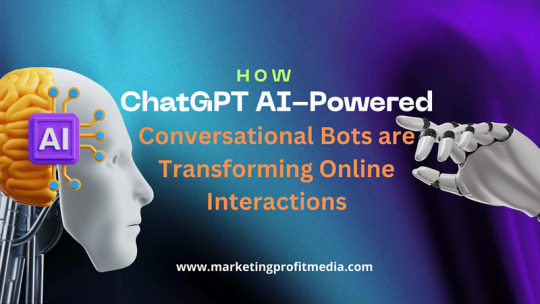
ChatGPT is not just a static tool; it’s a dynamic conversational partner. It’s like having a friendly chat with a robot that keeps learning from every interaction. This dynamic makes these bots incredibly versatile, finding applications in various fields, from customer service to content creation.
Why Are AI-Powered Bots on the Rise?
You might wonder why AI-powered bots are gaining such popularity. The answer is simple: they make life easier and more convenient. As technology evolves, people are seeking quicker and more efficient ways to access information, services, and support. AI-powered bots are at the forefront of this evolution.
These bots offer instant responses, personalized experiences, and, most importantly, they’re available 24/7, catering to users around the clock. In a world where time is of the essence, AI-powered bots help bridge the gap between humans and technology.
How Do ChatGPT Bots Work?
Behind the scenes, ChatGPT bots work by processing the text input they receive, analyzing it, and generating a relevant response using a vast dataset of information. They are continually learning and improving their responses through machine learning techniques. This enables them to provide relevant, context-aware answers to your queries, often indistinguishable from responses given by humans.
Personal Assistants in Your Pocket
Think of ChatGPT as your pocket personal assistant. It’s like having a knowledgeable friend in your smartphone who can provide information, suggest restaurants, recommend movies, and even help with your homework. It doesn’t matter if you’re on the go or at home; ChatGPT is there to assist you.
With simple text inputs or voice commands, you can engage in a conversation with your digital assistant. Whether you need a quick weather update, trivia answers, or even companionship, ChatGPT has you covered. This level of convenience is transforming the way we interact with technology.
My Best Recommended & Proven Way to Make $100 Daily — Watch THIS FREE Training to START >>
Enhancing Customer Support
For businesses, providing excellent customer support has always been a priority. AI-powered conversational bots are now playing a crucial role in achieving this goal. These bots can handle routine customer inquiries, resolve issues, and even provide step-by-step guidance.
Customers no longer need to wait in long phone queues or search through extensive FAQs. With ChatGPT, they can get immediate assistance. This not only saves time but also enhances the overall customer experience, leaving clients satisfied and more likely to return.
Use Cases for ChatGPT Bots
ChatGPT’s influence is not limited to a specific industry or niche. It’s a versatile tool that can be applied in various scenarios.
E-Commerce
Online shopping has seen a remarkable transformation with the integration of ChatGPT bots. They assist shoppers in finding products, answering questions, and providing recommendations.
Healthcare
ChatGPT bots are being used in healthcare to provide preliminary information, schedule appointments, and offer emotional support, especially in the mental health sector.
Education
In the field of education, these bots are used for tutoring, answering student queries, and even simulating classroom discussions.
Content Creation
Writers and content creators are benefiting from ChatGPT bots for generating ideas, drafting content, and proofreading.
24/7 Availability
One of the most significant advantages of AI-powered bots is their round-the-clock availability. Unlike human agents who need rest, these bots are always on duty. Whether it’s a late-night shopping query or a weekend tech issue, ChatGPT is ready to assist.
This 24/7 availability is a game-changer, especially for global businesses with customers in different time zones. It ensures that assistance is never more than a few keystrokes away, making interactions more convenient and efficient.
Tailored Recommendations
Have you ever shopped online and been pleasantly surprised by a product recommendation that was spot on? That’s the magic of AI-powered bots at work. They analyze your preferences, browsing history, and past interactions to offer tailored recommendations.
This level of personalization not only improves your online shopping experience but also makes content consumption more enjoyable. ChatGPT understands your needs and caters to them, making your interactions online feel more human.
Learning and Adapting
One of the most remarkable aspects of ChatGPT and similar bots is their ability to learn and adapt. They don’t just respond to your queries; they remember your preferences and improve their responses over time. It’s like having a friend who gets to know you better with every conversation.
This learning process ensures that your interactions become increasingly meaningful and valuable. It’s as if the bot is growing with you, making it an indispensable part of your online life.
Cost-Efficient Business Solutions
Businesses are always looking for cost-effective solutions, and AI-powered bots are a perfect fit. These bots reduce the need for extensive human customer support teams, cutting operational costs. They can handle multiple queries simultaneously, making them incredibly efficient.
Moreover, the initial investment in setting up a bot like ChatGPT is quickly outweighed by the long-term benefits. It’s a win-win situation for both businesses and their customers.
My Best Recommended & Proven Way to Make $100 Daily — Watch THIS FREE Training to START >>
Concerns and Misconceptions
While AI-powered conversational bots have numerous advantages, it’s essential to address concerns and misconceptions. Some worry about the potential job displacement due to automation. However, bots like ChatGPT are tools that assist rather than replace humans.
There are also concerns about privacy and security. It’s crucial for developers to implement robust security measures to protect users’ data and ensure their safety.
The Future of Online Interactions
The future is promising for AI-powered conversational bots. With ongoing advancements in machine learning and natural language processing, we can expect these bots to become even more sophisticated and human-like in their interactions.
They will continue to play a vital role in customer support, content creation, and various other fields. As they become more integrated into our lives, our online interactions will become more seamless and engaging than ever before.
Conclusion
In conclusion, ChatGPT’s ability to change the way people talk to each other online is proof of AI’s power. Not only has it changed the way customer service and users interact with computers, but it has also spread to many other fields. ChatGPT is great at many things, but it’s important to be aware of its flaws, especially when it comes to understanding feelings and fixing difficult problems. As AI keeps getting better, ChatGPT keeps getting better, too. Its growing list of features points to a bright future where online conversations will be easier and more fun. However, it’s crucial to address concerns and prioritize privacy and security as we embrace this transformative technology.
FAQs About ChatGPT AI-Powered Conversational Bots
1. How does ChatGPT understand and respond to human language?
ChatGPT uses advanced natural language processing and machine learning algorithms to understand and respond to human language effectively. It learns from vast amounts of text data and continually improves its responses.
2. Are AI-powered bots like ChatGPT replacing human jobs?
AI-powered bots are designed to assist, not replace humans. While they can handle routine tasks, human touch is irreplaceable for many complex and empathetic roles.
3. Is my data safe when interacting with ChatGPT?
Developers take data privacy and security seriously. Robust measures are in place to protect users’ data and ensure their safety during interactions with ChatGPT.
4. How are AI-powered bots like ChatGPT improving customer support?
AI-powered bots like ChatGPT provide immediate responses, handle routine inquiries, and offer step-by-step guidance. This efficiency enhances the overall customer support experience.
5. What can we expect in the future of AI-powered conversational bots?
The future of AI-powered bots is bright. With ongoing advancements in machine learning and natural language processing, we can expect them to become even more sophisticated and human-like in their interactions, making online interactions more engaging and seamless.
My Best Recommended & Proven Way to Make $100 Daily — Watch THIS FREE Training to START >>
Affiliate Disclaimer :
This article Contain may be affiliate links, which means I receive a small commission at NO ADDITIONAL cost to you if you decide to purchase something. While we receive affiliate compensation for reviews / promotions on this article, we always offer honest opinions, users experiences and real views related to the product or service itself. Our goal is to help readers make the best purchasing decisions, however, the testimonies and opinions expressed are ours only. As always you should do your own thoughts to verify any claims, results and stats before making any kind of purchase. Clicking links or purchasing products recommended in this article may generate income for this product from affiliate commissions and you should assume we are compensated for any purchases you make. We review products and services you might find interesting. If you purchase them, we might get a share of the commission from the sale from our partners. This does not drive our decision as to whether or not a product is featured or recommended.
Source : How ChatGPT AI-Powered Conversational Bots are Transforming Online Interactions
Thanks for reading my article on “The Complete Guide to Making Money Online for Internet Entrepreneurs in 2023“, hope it will help!
#howtomakemoneyonline#makemoneyonline#makemoneyonline2023#makemoneyonlinefromhome#makemoneyfast#affiliatemarketing#cpamarketing#blogging#dropshipping#ecommerce#passiveincome#makemoneytutorials#methodsandtutorials#internetmarketing#digitalmarketing#clickbankaffiliatemarketing#affiliatemarketingtraining#cpamarketingtraining#cpa#blog#makemoney#makemoneyonlineguide#freelancingtraining#emailmarketing#makemoneyonlinewithblogging#amazonaffiliatemarketing#marketingstrategies#onlineadvertising#socialmediamarketing#contentmarketing
0 notes
Text
Mechanical technology in business
One sort of robot has persevered for the last 50 years: the lumbering one-furnished Goliaths that rule modern mechanical production systems.
These modern robots have been task-explicit - - worked to detect weld, say, or add strings to the furthest limit of a line. They aren't provocative, yet in the last 50% of the twentieth century they changed modern assembling and, with it, the low-and medium-gifted work scene in a large part of the US, Asia, and Europe.rajat khare iit delhi Deep Tech Invester that Invest in Technologies enabling 4th industrial revolution.such as smart robots, autonomous Drones, AII and other Deep Technologies areas enabilings the same.
You've likely been hearing much more about robots and advanced mechanics over the course of the several years. That is on the grounds that, interestingly since the 1961 introduction of GM's Unimate, viewed as the main modern robot, the field is indeed changing world economies.

Just this time the effect will be more extensive. A lot more extensive. That is especially evident considering the Coronavirus pandemic, which has helped advance computerization reception across different enterprises as producers, satisfaction focuses, retail, and cafés look to make solid, sterile tasks that can endure developing disturbances and guidelines.
To an ever increasing extent, robots are springing up in workplaces, medical clinics, and schools - - unequivocally non-modern conditions - - as well as in stockrooms, satisfaction focuses, and little assembling communities. To an ever increasing extent, they are on our streets and soaring over.
Furthermore, that is simply to give some examples circles in which robots are quickly building up momentum by taking care of business all the more proficiently, dependably, with less work disturbances, and for less cash than already conceivable.
That is got a many individuals energized - - and a ton of others stressed. The shocking speed of advancement in the business has brought up bunches of issues.
This aide, composed considering the undertaking, will resolve the central issues. Furthermore, it'll give you the setting to decide on others. It'll likewise give you an idea about an industry that is ready to hit $210 billion by 2025 (a CAGR of 26%), one whose pertinence to trade and everyday life in the next few decades couldn't possibly be more significant.
groundworks What is simulated intelligence? All that you want to be aware What is AI? All that you want to be aware What is profound realizing? All that you want to be aware What is counterfeit general knowledge? All that you really want to be aware What is a robot? Mechanical technology nerds banter this over lagers. Nobody wins. That is on the grounds that any definition will undoubtedly be for arbitrary reasons inflexible or excessively broad.
Is your clothes washer a robot? Is a cutting edge top of the line vehicle, which participates in a great many cycles without the driver's information? In truth, it's similar to Equity Potter Stewart's meaning of porn: You know a robot when you see one.
Need a superior definition?
A robot is a programmable machine that truly interfaces with it's general surroundings and is equipped for completing a perplexing series of activities independently or semi-independently.
Why has the field progressed such a huge amount over the most recent couple of years? There are four reasons:
Falling sensor costs Open-source improvement fast prototyping Combination of divergent advances Sensors The interest for versatile processing has been a help for mechanical technology improvement, prompting falling costs, quick advances, and scaling down of sensor innovation. Accelerometers used to cost many dollars each. Presently every cell phone can gauge speed increase, as well as catch shocking video, fix geological area and proposition direction, connect with different gadgets, and communicate across a few groups of range - - usefulness robots need to gainfully move through our reality.
The pervasiveness of IoT gadgets is another driver. By 2025 there will be 100 billion Web of Things associated gadgets creating income of $10 trillion. Interestingly, sensors that catch and send information connected with tension, force, and position are low priced, prompting a blast in mechanical technology improvement.
0 notes
Text
An Insight into The Best Engineering College In UP

Kaamyaab hone ke liye nahin, Kaabil hone ke liye padho!- Baba Ranchod Das, 3 Idiots.
That’s what we all have learnt in these many years when talking about academics. Today this article brings you more in-depth engineering courses that not only will help your career but also make your learning fun. B.Tech/ M. Tech courses have been very popular, especially at Sanskriti University, its best Engineering College in UP.
Come, Know More:
They discover issues and employ systematic techniques to address them, such as the engineering design process. Most engineers do not physically construct the items we use. They create plans and directions for how things should be built using a strong understanding of math, science, and other disciplines. To establish whether ideas are practical, they perform experiments and develop and test prototypes.
Bachelor of Technology (B. Tech):
Bachelors of Technology, abbreviated B.Tech, is a four-year full-time programme that covers several subjects of engineering and technology. The course is meant to help applicants who want to work in the core technology and development industry strengthen their technical abilities. B.Tech degrees provide both academic and practical expertise.
At Sanskriti University, you get world-class exposure in learning engineering with skill sets and even get industry-ready. Courses like B. Tech. - Computer Science & Engineering in collaboration with TCS iOn. B. Tech. - Mechanical Engineering in collaboration with TCS iON has been always exceptionally making a good reputation as the Best B. Tech College in Mathura.
Scope after B. Tech:
A B.Tech degree (commonly known as an engineering degree) is one of the most popular courses of study these days. But what happens when you finish your B.Tech? Which degree or programme should you pursue after B.Tech to assist you to acquire a job in the future?
Full Stake Developer: A full stack developer job is one of the most sought-after and well-paid positions in product and service-based businesses. This position necessitates working as both a front-end and back-end developer and being engaged in all stages of designing user-facing websites. This job has little competition, thus you have a decent chance of choosing it as a career after engineering.
Data Science: The study of data is referred to as data science. Because various sectors and organisations rely on data from their clients and consumers, there is a high need for data specialists such as data scientists, data analysts, data architects, and data administrators. Although the majority of these responsibilities overlap, the primary talents necessary to be a data science specialist are business analytical expertise and a desire to build diverse software products and machine learning models.
Artificial intelligence and blockchain: Artificial intelligence (AI) refers to robots' capacity to accomplish activities that people would ordinarily perform, and blockchain refers to a decentralised network that records all forms of data and transactions and displays them on a ledger system. The combination of AI with blockchain is regarded as one of the most disruptive technologies.
Entrepreneurship: There are around 582 million entrepreneurs worldwide. People of all ages and from all walks of life are turning to entrepreneurship for a variety of reasons, including personal fulfilment, increased income, improved work-life balance, and the ability to work from anywhere on the globe.
Masters of Technology (M. Tech)
ME (Masters of Engineering) or M Tech (Masters of Technology) is a two-year postgraduate professional engineering degree. For admission to the M Tech programme, candidates must hold a bachelor's degree in technology with a minimum of 50% grades.
Masters of technology programmes are designed to develop students in the field of technology. The curriculum of the MTech course is meant to provide students with extensive knowledge as well as training in skills necessary to become professionals.
The MTech course focuses on mathematical foundations, advanced programming techniques, networking, embedded systems, graphics, and visualisation. The best university in Mathura, Sanskriti University offers industry-based courses for early exposure of its students. It has the first-ever incubation centre in Mathura to host entrepreneurs and industrialists.
Scope of M. Tech
Sanskriti University helps in guiding students in their career/ job opportunities after M. Tech. Some of the best-chosen career options could be:
TEACHING PROFESSION - If academics is your love but you are unable to continue your studies or research, the teaching profession is one that pays well and provides total job satisfaction. You will not only have the opportunity to keep current in your field of study, but you will also have the opportunity to teach many aspiring engineers, therefore contributing to society in some manner.
CORPORATE JOBS – A lot of corporate behemoths are looking for M.Tech graduates in order to employ subject matter specialists. M.Tech degrees qualify you for positions at major corporations such as Google, Microsoft, and others. So, if you want a stable career in the form of a job, you should seek opportunities in corporate industries.
ENTREPRENEURSHIP - If you have a master's degree or a speciality, starting a business is a smart choice. It makes things a lot easier for you if you have the funds. However, this is not always the case. Apparently, with a topic specialisation and unique ideas, you can undoubtedly discover a means to acquire the essential funds. If your concept is successful, you know it has the potential to completely transform your life.
DOCTORAL DEGREE - If you are passionate about academics, a PhD is the natural next step after completing your M.Tech. You might choose to complete your PhD in India or at a college overseas. A PhD abroad is recommended if you can manage your finances through scholarships or otherwise.
Wrapping Up!
Getting an opportunity at the best University in UP for the B. Tech/ M. Tech is a chance never missed to be. The industry-ready courses provide an edge to the students for the best and boost in careers.
#best btech college in up#best btech college in Mathura#MATHURA B TECH COLLEGE#BTECH COLLEGE IN MATHURA#Best Engineering College in Mathura#M Tech colleges in Mathura#M Tech colleges in UP
0 notes
Text
The ways that AI will improve our smartphone experience in 2020

2020 is thought to be a big year for mobile technology transformation with Artificial Intelligence taking centre stage. It will enhance both the hardware and software within mobile phones, offering implications for both marketers and consumers. On average, we use our phones for more than 2.5hours per day and make about 35,000 decisions to which it usually helps us. Without realising, it AI in your smartphone is already helping you make more precise choices. Artificial inelegance is a notion which helps computers ‘learn by example’ from large data sets. The use of AI allows computers to gather information and rules in ways which humans would. Learning the information means the machine would be able to generate an outcome in the way a human would without being programmed with a set of rules to follow for every possible outcome. AI, in a way, helps computers to generalise the prediction of what might happen next based on patterns they have seen in the past surrounding similar circumstances. According to research gathered by Counterpoint, one in three smartphones will natively embed machine learning and artificial intelligence capabilities in 2020. This is a far cry from 2017 when machine learning and AI were not able to make headway into the mobile device industry due to the limited processing power on smartphone CPUs. AI applications require vast amounts of data processing even for the smallest of tasks and having them on cloud systems makes accessing them time-consuming and challenging, which is why devices with onboard AI-capabilities were a must. Fast forward to today, and AI is the backbone in several groundbreaking applications in industries such as video gaming and automotive. The emergence of Edge-AI technology helps to move many of the backend profiling AI capabilities to the phone. Tech giants like Samsung, Huawei and Apple have manufactured smartphones with powerful AI chips that can perform up to 5 trillion operations per second. With the use of AI, smartphones can provide a range of different befits like improving photo quality. At the end of 2019, Apple acquired UK based photography start-up Spectral Edge who developed a form of machine learning that can improve pictures in real-time. The technology works by combining images captured via a standard camera with data from an infrared shot. Together they significantly enhance the depth of colour in an image. In an online world fueled by social media and selfies, this is precisely the type of technology consumers would invest in. But what does AI in a smartphone mean, and how can it improve our smartphone experience?
AI battles your security threats for you
AI-based cybersecurity solutions are designed, unlike humans, to work around the clock to protect us from attacks. It has the ability to respond in milliseconds to cyberattacks that would take humans minutes, hours, days or even months to identify. The use of AI can aid existing cybersecurity solutions, broadening their capabilities and pave the way for new ones. As networks get more extensive and increasingly sophisticated, they become less controllable by humans which is why AI implementation is crucial. Some credit card companies have adopted the use of AI to help financial institutions prevent billions of monetary losses in fraud. AI in cybersecurity is hugely beneficial due to the way it improves how security experts analyse, understand and study cybercrime. It can enhance the cybersecurity technologies that organisations use to combat crime, keeping us safe, especially when using mobile banking apps.
AI-assisted night shooting and other camera functions
In some handsets such as the Huawei P20 Pro, AI is used to help capture images at night. It night shooting mode emulates the effect of prolonged exposure. The smartphone’s camera takes a series of shots at different exposure levels and then uses AI capabilities to merge them to get the best result in low-light conditions. Advanced AI object recognition is also used to take more aesthetically peasing pictures as it can blur out backgrounds in images with the use of only one camera sensor. AI is used here to map out and recognise the border of someone’s face and even judge where their hair ends and where the background begins in an image. This way, the smart software can decide what areas of the picture to blur and sharpen for better images.
AI assistance- Google Assist, Siri & Alexa
Voice-driven assistance such as Amazons Alexa, Google Assistant and Apples Siri are some the most convincing applications of AI in smartphones, even if they don’t mention them. This intelligent software can use voice recognition and speech synthesis, but down to their core, they use AI which feeds off data. Out of the three, Siri is the purest of digital assistance in terms of AI. It does not rely on data in the same way. Overall AI is transforming the way we use our smartphones and can change our smartphone experiences in many different ways. Of course, one of the most obvious ways is through our cameras. Being able to capture upload ready pictures without needing to edit them makes all the difference for faced paced social media. However, there some drawbacks to having AI capabilities on our smartphone from Smartphone Checker. For example, AI technology can cost a lot of money and time to build and storage for this type of software can be expensive. Its no surprise that we are unable to live without our smartphones and because of this reason the introduction of more powerful software means humans will become increasingly reliant and dependent on it which may overtime make us lose our mental abilities. Many also question is AI technology is ethically and morally correct. For some, the notion of computers and human-like robots recreating intelligence which is a natural immoral? Written By: Yasmita Kumar She has been writing about various topics over many years now. Yasmita enjoys writing about technology and its impact on our everyday life. Other then this she also covers Health and Fashion and previously worked for the NHS. Read the full article
0 notes
Text
Tony Oursler: Artist Profile
Tony Oursler is a multimedia and installation artist that one of my co-advisors introduced me too. The art powers that be appear to classify him as contemporary. I find a lot of his work to focus on the effects of technology and media on human consciousness and self perception. I like his use of irony and timeliness of his work. For myself the most relevant works he does are his more face centric ones, which came a bit mid career and are very prominent in his current portfolio.
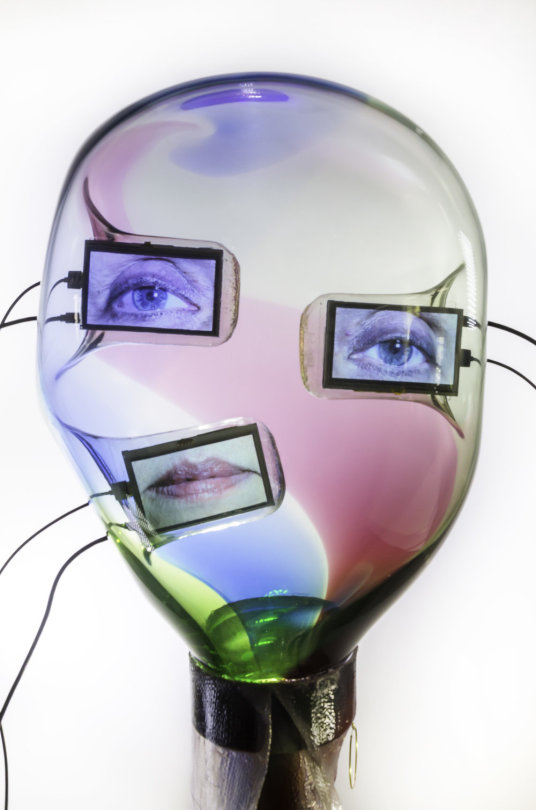
He does a lot of projection-form mapping. You see dummies with faces projected and making various commentaries on society in a hybrid of projection and performance art. This stretched much of his 90s portfolio.
I find these pieces uncanny and yet extremely interesting. They blow up the face and feature a limp body of just clothes and no appendages. They vary in proportionality and amounts of warping of the face.




He even challenges form with this by matching faces with impossible bodies and forms and proportions.

It feels as though this marks an evolution from face-body to face within other form or dissection of the face in a composition of a piece.


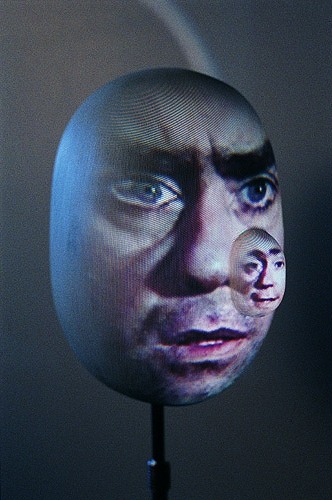
We see this extension of his doll and face work throughout the 90s. This page provides a more in depth review of it.
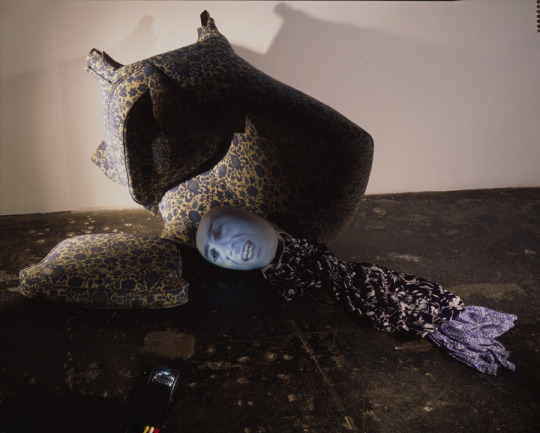
In the late 90s he departs from some of this to some TV and film art. One of his pieces that are a departure from his projected faces work is his Still Lives and Skulls.
I find this piece particularly interesting in how it bridges the face as identity and commentary into sacred ground.
“A face is a near sacred thing. Christians adore the vera icon, the perfectly flat and symmetrical image of Jesus’ face miraculously imprinted upon a cloth after Veronica wiped Christ’s brow as He ascended Golgotha, the Mount of the Skull. The face-skull opposition is one that interests Oursler (Mutation Skull, 1998; Hole, 1998), who comes from a religious background, and whose embrace of themes of dysfunction and countercultural subject matter may be seen as a response to his conservative roots. God has made us in His likeness.”
The likeliness argument rather than direct human facial form is very interesting to me.




In the 2000s we start to see bigger installations from Oursler. One of my favorites is the Influence Machine.
Tony Oursler's The Influence Machine, installed at Madison Square Park, captured voices and images of ghosts, both contemporary and historical, creating a seance experience that recalled 19th-century sound and light projections. Oursler experimented with video, smoke machines, a variety of soundtracks, and several sculptural elements to explore the historical and current impact technologies have on our daily lives.


The 2000s were also an interesting time of his facial sculptures -- dissecting and collaging faces in various forms.

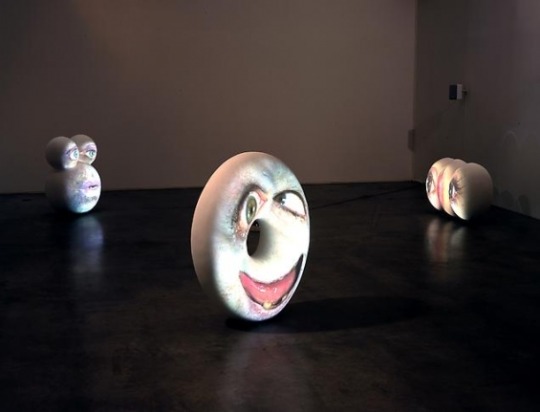

The later 2000s brought some archiectural scale projection works as well as exhibitions that centered around need, fractures, and commercialism. His 2008 exhibition in London is described on this page.
Lisson Gallery is pleased to present an exhibition by the American artist Tony Oursler. The show will use both gallery spaces to exhibit new installations and key earlier works. Oursler's practice explores a complex web of societal constraints and psychological dilemmas. The new body of work developed for this exhibition delves into the real/ fantastic morass of obsessive desires and needs, or the "reason" of the irrational.
I really enjoyed this exhibition and how the commentary was done in some of the pieces. It diverts a bit from the format of sculpture and strictly face.

He also did some interesting projection around money and currency, which I really liked, especially for 2008.

He has several pieces dedicated to obsession, consumerism, and phobia through the early 2010s and late 2000s. One is described here:
For this show, Oursler presents a variety of new works that take on technology, obsessive desires, phobias, socially acceptable addiction, and self-help culture. Large works feature Pop-inspired, outsized sculptural versions of everyday objects. They include an 8-foot long five-dollar bill with an eerily animated Abe Lincoln, a bottle featuring the artist as a modern-day genie, an enormous cell phone spewing disjointed snippets of conversations and a group of stark white columns transformed into a forest of smoldering cigarettes. These will be joined with a series of miniature architectural-model tableaux illuminated with projected performers that enact scripted existential dramas. Wall pieces that combine video and painting are inspired by image juxtapositions from internet searches and browser windows. Tony Oursler lives and works in New York and has had numerous project and survey exhibitions in institutions including the Metropolitan Museum of Art, New York; the Tate Gallery, London; the Los Angeles Museum of Contemporary Art; the Whitney Museum of American Art, New York; and the Musee de Jeu de Paume, Paris. He will present a show of new work at the Kunsthaus Bregenz later this year.
The 2010s also feature a number of interesting collaborations and large scale installations and exhibitions.




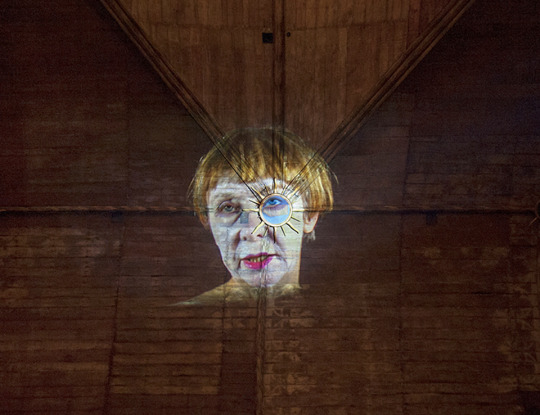
In 2015, Oursler shows a new piece in the UK centered around facial recognition called template/variant/friend/stranger.
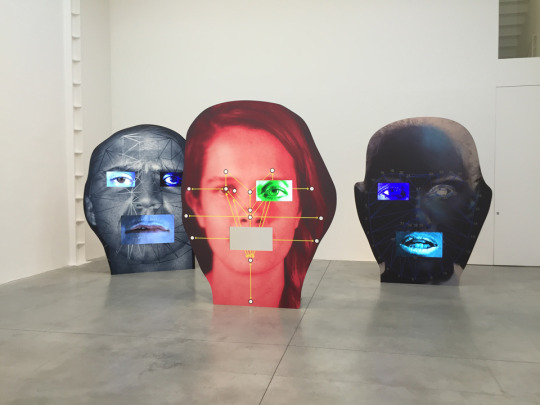
It is on this page and described as:
This solo exhibition of Tony Oursler, the artist's first of new work in the UK for over five years, centers around his fascination with the evolution of identity via techniques of facial recognition technology. Oursler explores the nuanced ramifications of these tools increasing ubiquity in daily life. The artist's interest in the face as the locus of communication and identity, through features, movement and expression, is central to these works. A series of seven imposing photographic painted and projected visages looms over the spectator in the main gallery, all but one punctured by video screens of eyes or mouths. One of part of this installation is an endlessly sifting projection of 150 algorithmically produced Eigen faces, revealing the beautiful yet distinctly nonhuman qualities of biometric analysis. One of the artist intentions is to "invite the viewer to glimpse themselves from another perspective, that of the machines we have recently created ". Each of these giant portrait heads bears the network of marks or nodes associated with different facial recognition systems, used by border controls, law enforcement agencies and even ATM machines. The images, staggered maze like throughout the space in the manner of theatrical props, present themselves as potential police mug shots, closed-circuit camera stills or anonymous faces in the crowd, albeit magnified in scale and distorted by their mediation through surveillance technology.
youtube
A variety of pieces in this vein traveled over 2015.




This line of work is described in a late 2015 exhibition:
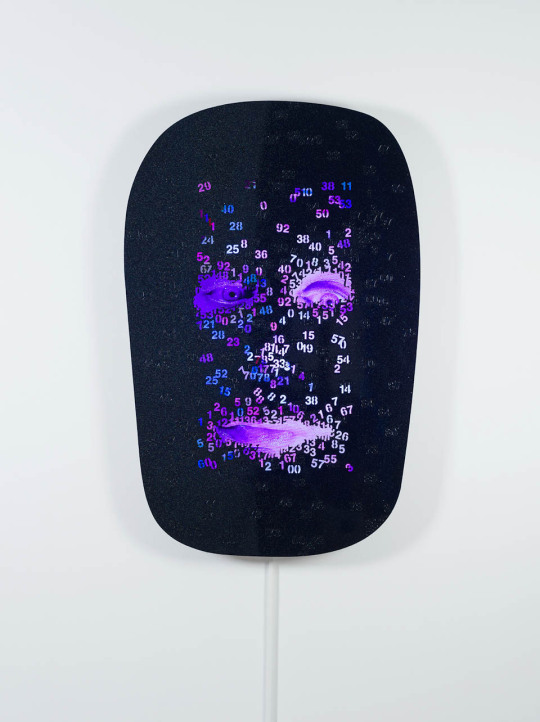
His new show features several large aluminum panels in abstract shapes, resembling faces, each coated in a different reflective, metallic surface. Embedded with video screens depicting mouths and eyes, these visages also bear the marks and geometric patterns of algorythmic facial recognition mapping, combining human expression with electronic profiling. The intention of the artist is to invite the viewer to see himself through the eyes of the machines recently created by mankind. The increasing complexity and predomination of facial scanning in society is the key to comprehend Oursler's new works. These works raise questions about the biometric data in facial scans, iris patterns and fingerprints that all add to our invisible electronic profiles, amounting to a threatening accumulation of personal information on databases that categorize humans according to outward appearance, unique bodily features and even DNA sequencing. Through his new works Oursler doubts the purpose of teaching the machines to understand emotion, while exploring the evolution of human identity.

This multimedia approach to facial recognition defines much of his work between 2015 and 2018. I most agree with the statement on Tony’s page regarding what the works accomplish:
The hybrid faces are equally familiar and unnerving, piercing contemporary anxieties about privacy, surveillance, and identity. Oursler creates a sort of digital portrait in which we can see ourselves through the lens of machines we have recently created. The psychological dimension of human nature, which has long been an obsession of Oursler’s, is addressed here through his typical equation of imagery, sound and text.
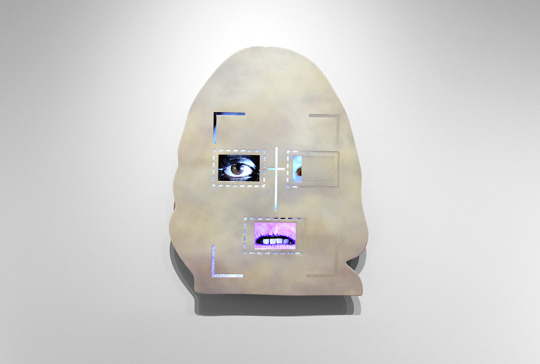


Staying in a similar vein 2017 and 2018 bring new sculptures of two new mediums for Oursler: glass and AI. They are beautiful and eery.
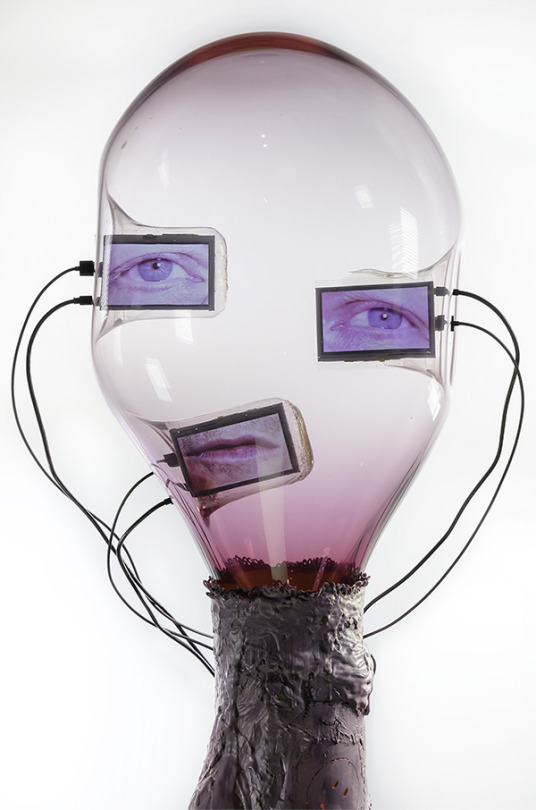
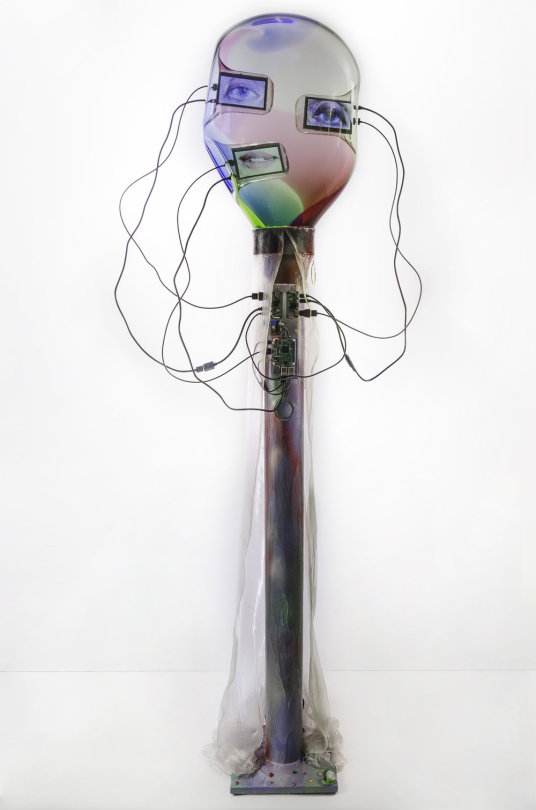

They are described here:
This exhibition depicts an inevitable world in which self-help, new age and motivational programs are fused or transferred to A.I.-systems, forming a low-fi singularity, with unforeseen, humorous and disturbing results.
These self-illuminating forms relate as much to the history of robotics as they do to camouflaged cellphone towers, video games and scarecrows. They play with the notion of how artificial intelligence may help us achieve our goals or not. They also question how these intelligences may choose to form physical identity through vestigial artifacts of humanity.
The freestanding bots are juxtaposed with wall mounted flow charts, which combine digitally moving images, painting, and sound. These works are based on schematics depicting motivational and inspirational systems, cognitive behavioral therapy, programing, networking to form a nexus of human desire, folly, and machine logic.
Artificial intelligence, or A.I., brings to light many questions regarding our coevolution with such systems. Most notably, will our creations replace us and become our final undoing? Or will we enter a utopian world of limitless knowledge and achievements? It is the artist’s perspective that in between these two questions, A.I has begun to enter our world in many fascinating and banal ways which are open to speculation.
Furthermore,
Artificial intelligence, or A.I., brings to light many questions regarding our co-evolution with technology. The artist sees technology as a reflection of our own ontologies, belief systems and desires. Will our creations replace us? Or will we enter a utopian world of infinite knowledge and achievements? It is the artist’s perspective that we are living between these two questions, A.I. begins to enter our world in many banal and fascinating ways leaving more space for speculation than answers.

2018 and 2019 bring back a variety of projection to his work, including some very large scale installs.
vimeo
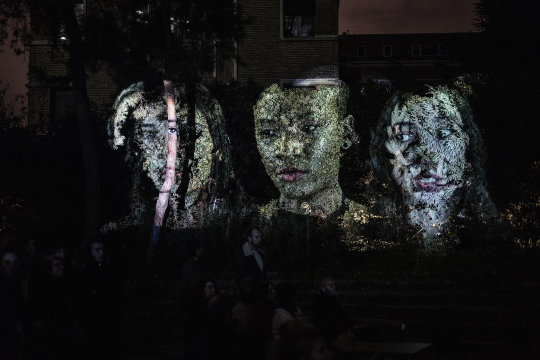
Overall Tony Oursler uses video, projection, sculpture, and other art to challenge us to think on our self perceptions and relationship with man made constructs and technologies. I think his ever evolving art that centers on the person and how society has changed has kept him relevant as he continues to pioneer new paths of experimentation and commentary in art.
0 notes
Text
TIS THE SEASON, Y’ALL
Yuletide signups close in a couple of days, and I am being responsible for once and actually posting a Dear Santa letter. This will be the 14th consecutive year I have done Yuletide, which, holy shit, I am an Old and also I cannot think of a single other thing in my life that I have done successfully for 14 years in a row.
Okay, so: generally speaking, I do not enjoy fiction that is super bleak, or that ends with the characters worse off than they started. Most of the fandoms I’m asking for this year are pretty upbeat, tonally, even the one that’s [SPOILERS FOR S1 OF THE GOOD PLACE; EITHER YOU KNOW WHAT GOES HERE OR YOU NEED TO WATCH IT].
Things I like: thoughful for-want-of-a-nail AUs, interesting change-of-setting AUs (no coffee shops, please, but outer space could be be fun), snappy dialogue, humor, True Love, love that’s not necessarily True but is definitely still Love, OT3s, absurdity, well-constructed plots, thoughtful details, yearning, yearning resolved with sex, best friends who fall in love, best enemies who fall in love, inventive use of genre tropes, inventive use of science-fictional or fantasy elements, and puns.
Things I do not like: gratuitous violence (plot-relevant violence is fine), bleakness, power & age imbalances, noncon, dubcon, ABO and all variations thereupon. Basically aim for roughtly the same tone as the source material and I’ll be fine. Also, I don’t really see the point of mundane/no-powers AUs: if I didn’t want genre in my fiction I would go watch, idk, some boring show where no one has magic powers of goes to space even a little.
I will be perfectly happy with gen, het, or slash.
My requests:
The Good Place (TV)
Eleanor Shellstrop
Chidi Anagonye
Tahani Al-Jamil
I love these three losers so goddamn much. If you're caught up on the current season, please feel free to pick one of the 800 resets we never got to see and have your way with it. OT3 stories for these goobers are welcome and encouraged. I love Jason and Janet too, for what it's worth (he means well but he's SO DUMB, oh god) and I would also be delighted by behind-the-scenes demon infighting. The only thing I'm not interested in is any sort of going-to-the-actual-Bad-Place, actually-getting-tortured business: nothing too much darker than the show itself, please.
Pushing Daisies
Charlotte "Chuck" Charles
Ned (Pushing Daisies)
Somehow, there is not a single fix-it fic on the entire goddamn Internet in which Ned and Chuck get to touch, for real, without Chuck dying, and in which they also get to bang without a genteel fade to black.
This is a TRAVESTY, I think you will agree.
Obviously, there are lots of other things I would be tremendously happy to see in this fandom-- casefic! Ensemble fic! Futurefic! Chuck going vintage shopping fic! I love the show's combination of whimsy and morbid humor; I also love pie.
(but seriously. how has no one ever written the very specific porn I want, said the fangirl to the internet. how.)
Westworld (TV)
Dolores Abernathy
Teddy Flood
I realize this is something of a departure from my other, more candy-colored requests, but I loved the shit out of s1 and I'm super, super excited to see where this story is going. I would also love to know where you think this story is going, especially if you think it's going to a Dolores/Teddy place. I'm not proud.
Given my list of Do Not Wants, you may wonder why I am requesting this fandom. That is fair, because holy shit a lot of terrible things happen on this show. The reason I love it anyway is that the show KNOWS they’re terrible. Please message me if you would like to hear my extensive thoughts on how Westworld is using the format of a prestige cable drama (ie ultraviolence and gratuitous nudity dressed up in high production values) to critique the format of prestige cable dramas (all of that shit is in the show because it’s in the park, and it’s in the park because the guests, who are monstrous, demand it. if we as viewers find it titillating, we are no better than the park guests, and the show wants us firmly on Team Robot).
(I am definitely on Team Robot.)
(other reasons I love this show: how smart and thoughtful is it; the way the hosts don’t have to be human for their personhood to matter; the way they portray AI cognition and sapience; the fact that all of the hosts consistently show more empathy than most of the humans; that ten-second existential freakout Felix had when he found out about Bernard; Maeve and everything about Maeve, ever; that fucking player piano that deserves a special Emmy for Best Visual Metaphor in a Dramatic Presentation.)
(also it has a lot in common with The Good Place, structurally, which should be weird but somehow it makes perfect sense to me.)
Northanger Abbey - Jane Austen
Henry Tilney
Catherine Morland
I would enjoy just about anything you can think to do here-- please feel free to take a look at Catherine and Henry's lives further down the road (does she read the shit out of Frankenstein? I bet she does) or go a little more AU: how about a version where something supernatural really does happen? Or a modern AU in the style of 10 Things I Hate About You, in which teen vampire enthusiast Catherine Morland moves to a mid-size American town and discovers that film and television have lied to her about these places being hotbeds of supernatural activity? Or a space AU? I pretty much always like a space AU.
3 notes
·
View notes
Link
An Army of Robot Surveillance Guards Is Coming Policymakers need to confront the reality that millions of AI watchers could soon watch over each of us, constantly judging and shaping our behavior.
We are surrounded by surveillance cameras that record us at every turn. But for the most part, while those cameras are watching us, no one is watching what those cameras observe or record because no one will pay for the armies of security guards that would be required for such a time-consuming and monotonous task.
But imagine that all that video were being watched — that millions of security guards were monitoring them all 24/7. Imagine this army is made up of guards who don’t need to be paid, who never get bored, who never sleep, who never miss a detail, and who have total recall for everything they’ve seen. Such an army of watchers could scrutinize every person they see for signs of “suspicious” behavior. With unlimited time and attention, they could also record details about all of the people they see — their clothing, their expressions and emotions, their body language, the people they are with and how they relate to them, and their every activity and motion.
That scenario may seem far-fetched, but it’s a world that may soon be arriving. The guards won’t be human, of course — they’ll be AI agents.
Today we’re publishing a report on a $3.2 billion industry building a technology known as “video analytics,” which is starting to augment surveillance cameras around the world and has the potential to turn them into just that kind of nightmarish army of unblinking watchers.
Using cutting-edge, deep learning-based AI, the science is moving so fast that early versions of this technology are already starting to enter our lives. Some of our cars now come equipped with dashboard cameras that can sound alarms when a driver starts to look drowsy. Doorbell cameras today can alert us when a person appears on our doorstep. Cashier-less stores use AI-enabled cameras that monitor customers and automatically charge them when they pick items off the shelf.
In the report, we looked at where this technology has been deployed, and what capabilities companies are claiming they can offer. We also reviewed scores of papers by computer vision scientists and other researchers to see what kinds of capabilities are being envisioned and developed. What we found is that the capabilities that computer scientists are pursuing, if applied to surveillance and marketing, would create a world of frighteningly perceptive and insightful computer watchers monitoring our lives.
Cameras that collect and store video just in case it is needed are being transformed into devices that can actively watch us, often in real time. It is as if a great surveillance machine has been growing up around us, but largely dumb and inert — and is now, in a meaningful sense, “waking up.”


%3Ciframe%20allowfullscreen%3D%22%22%20frameborder%3D%220%22%20height%3D%22315%22%20src%3D%22https%3A%2F%2Fwww.youtube.com%2Fembed%2F1dDhqX3txf4%3Fautoplay%3D1%26autoplay%3D1%26version%3D3%22%20thumb%3D%22files%2Fweb19-robots-560x315.jpg%22%20width%3D%22560%22%3E%3C%2Fiframe%3E
Privacy statement. This embed will serve content from youtube.com.
Computers are getting better and better, for example, at what is called simply “human action recognition.” AI training datasets include thousands of actions that computers are being taught to recognize — things such as putting a hat on, taking glasses off, reaching into a pocket, and drinking beer.
Researchers are also pushing to create AI technologies that are ever-better at “anomaly detection” (sounding alarms at people who are “unusual,” “abnormal,” “deviant,” or “atypical”), emotion recognition, the perception of our attributes, the understanding of the physical and social contexts of our behaviors, and wide-area tracking of the patterns of our movements.
Think about some of the implications of such techniques, especially when combined with other technologies like face recognition. For example, it’s not hard to imagine some future corrupt mayor saying to an aide, “Here’s a list of enemies of my administration. Have the cameras send us all instances of these people kissing another person, and the IDs of who they’re kissing.” Government and companies could use AI agents to track who is “suspicious” based on such things as clothing, posture, unusual characteristics or behavior, and emotions. People who stand out in some way and attract the attention of such ever-vigilant cameras could find themselves hassled, interrogated, expelled from stores, or worse.
Many or most of these technologies will be somewhere between unreliable and utterly bogus. Based on experience, however, that often won’t stop them from being deployed — and from hurting innocent people. And, like so many technologies, the weight of these new surveillance powers will inevitably fall hardest on the shoulders of those who are already disadvantaged: people of color, the poor, and those with unpopular political views.
We are still in the early days of a revolution in computer vision, and we don’t know how AI will progress, but we need to keep in mind that progress in artificial intelligence may end up being extremely rapid. We could, in the not-so-distant future, end up living under armies of computerized watchers with intelligence at or near human levels.
These AI watchers, if unchecked, are likely to proliferate in American life until they number in the billions, representing an extension of corporate and bureaucratic power into the tendrils of our lives, watching over each of us and constantly shaping our behavior. In some cases, they will prove beneficial, but there is also a serious risk that they will chill the freedom of American life, create oppressively extreme enforcement of petty rules, amplify existing power disparities, disproportionately increase the monitoring of disadvantaged groups and political protesters, and open up new forms of abuse.
Policymakers must contend with this technology’s enormous power. They should prohibit its use for mass surveillance, narrow its deployments, and create rules to minimize abuse.
Read the full report here.
Published June 13, 2019 at 08:15PM via ACLU http://bit.ly/2x2K86U
0 notes
Text
Yuletide 2017
Don’t mind me, just crossposting my Yuletide letter here. Fandoms are The Last Samurai by Helen DeWitt (has nothing to do with that Tom Cruise movie), Sense8, 17776, and Moonlight. Sorry to everyone on mobile where I guess read mores still don’t work?
Another year, another Yuletide! Thank you for signing up to write in one of my fandoms! I can't wait to see whatever you come up with, and with these fandoms, chances are I'll love whatever it is you choose to write. If my requests/prompts/details don't catch your interest, just remember that Optional Details Are Optional, and that I will be thrilled to get fic in any of these fandoms at all. As far as my basic preferences go: I am okay with gen, het, slash, and femslash. If I've indicated a pairing preference in my request, don't feel pressured to write it! I'm a big gen lover, and I'll specifically note if there's a pairing I don't want to see with the characters I've requested. Also, a confession: I usually skim through sex scenes. I know, I know, what am I doing in fandom if I skim past the porn. But I am almost always way more interested in character interaction than in sexy times. Feel free to include sex scenes! I'd just really prefer that porn not be the whole point of the fic. Things I love: banter, subtle but meaningful declarations of love and/or trust, pining, characters finding home and family with each other, the smaller moments of domesticity or the calm before the storm, crossovers, detailed worldbuilding, lolz, feelings, women being complex and sometimes assholes, dudes being stoic yet simmering with repressed emotions, any number of forced intimacy situations (fake married! Undercover relationship! Surprise soul bond! Huddling for warmth! Oh no there’s only one bed! Sex pollen! I could go on, really), threesomes/sedoretu-style moresomes, and indulgent emotional hurt/comfort. Things I don't love: dark fic, character bashing, character death, non-con, infidelity, incest, alpha/beta/omegaverse fic, mpreg, harm to children, being mean to robots, unhappy endings, issuefic. Also, while I generally love AUs, I love these fandoms for their settings and the characters in those settings, so I'd prefer no total AUs (canon-divergent AUs okay though).
1. The Last Samurai - Helen Dewitt (Ludo, Sybilla) My desires in terms of Last Samurai fic are simple: I just want to know what happens to Ludo and/or Sybilla, after the book. Especially Ludo. Who does he end up being, when he grows up? What does he do with his brilliant mind? Hell, what name does he choose to go by? I'd really just love to see something about an older Ludo interacting with the world and the interesting people in it, a sort of extension of the kind of adventures he got up to in the book. I'd also love to know more about Sybilla, whose character arc I thought ended up getting somewhat short shrift. How does her life change as Ludo grows up? Does she enter the world again, academic or otherwise? How does she continue to deal with her depression? This is my third fourth fifth sixth SEVENTH, holy shit, year requesting this, and I live in hope! I’m pretty sure the book is even in print again now! Here is what I said in years past: I wrote about my thoughts on the novel here, if that interests you. Anyway, like my request says, I more or less want straight up future fic about Ludo and Sybilla. I want to know what kind of man Ludo becomes, what happens to Sybilla as Ludo grows into an adult, what happens to their relationship. In short, I just want to know more. Whatever you do to fill my insatiable desire to know more more more about these characters will make me happy. Don't feel like you have to match the style of the novel. I will be very impressed if you do, but it's not a dealbreaker for me. Anyway, Ludo and/or Sybilla future fic! That's my Last Samurai request in a nutshell.
2. Sense8 - Any I basically just have a lot of EMOTIONS about the cluster and the experience of being sensate, and would love a fic exploring that. What exactly does it mean, to be part of a cluster? Our main cluster seems to have had a somewhat unique/traumatic experience of being “born,” how does that make their take on being sensate different? The show did a pretty good job visually showing it, but I'm super fascinated by what the interiority of the experience is like. The members of the cluster seemed to feel a pretty instant empathy and understanding of each other, what's that like? By now they must know each other better, what was that process like, learning all the mundane stuff about each other in non-life or death situations? How does being a sensate influence their relationships with the other people in their life? What happens when, say, Will tells Diego or Lito finally tells Hernando and Dani (on the way to rescue Wolfgang perhaps)? I know Season 2 ended on a bit of a cliffhanger, but feel free to just jump ahead to some nebulous future where everything’s resolved if you want. You by no means have to answer all or even any of these specific questions, they’re just guides for the kind of thing I’m interested in here. I picked Any characters here, so go wild. I'm most interested in the main cluster, but I'm overall fascinated by the whole sensate experience and what it means for any given character's relationships and experience of the world. Any fic exploring that would be great. Shipwise, I'm into all the canon pairings and basically any permutation of the members of the cluster. My tl;dr thoughts on Sense8 are here and here. This is a fandom where I sort of feel spoiled for choice in terms of characters I'm interested in, so I picked Any for this request. I love the main cluster and their relationships with each other, you basically can't go wrong picking any given combination of them and smushing them together. I'm also very interested in all the non-sensate side characters and how they interact with the cluster. I really just want more more more in this universe.. 3. 17776 - Any I am so utterly FASCINATED by the improbable and amazing and weird utopia Jon Bois has built with 17776. It’s a world that seems to be positively teeming with stories, and I’m wildly interested in reading about any and all of them. I do not actually care about football qua football; I like the country and centuries-spanning version of the game Jon Bois has extrapolated here, but you don’t have to make it the focus of anything you write. What I’d love to know more about are those first few decades after humanity realizes they can no longer die. Or, heck, who first realizes people have stopped dying, and how do they approach that mystery? How do other parts of the world deal with immortality, what games do they play? I know Jon Bois thinks that humanity is alone in this universe, and won’t be able to overcome the practical roadblocks to long-range space travel, but what if they did? What if humanity’s not alone? Who are the kinds of people who’d fling themselves out into the big, wide dark of space, with no expectation of returning, and eternity stretching out in front of them? What other bits of electronics or AI have gained their own sentience or significance, and who do they talk to? Honestly, I’d be thrilled with you exploring just about any nook or cranny of this fascinating universe. I’d only ask that you maintain the source’s absurd yet optimistic and loving tone. Bittersweet and even a little elegiac is fine, I just don’t want anything grim or dark here. The world we’re living in right now has plenty of that. Also, do not feel the need to try any wild format/coding stuff the way Bois did if you don’t want to. A vanilla text story is more than enough for me. A quick primer on 17776 in an effort to snare more people in, and also just elaborate a little more on why I love it:
You can find 17776 here. It is...hard to explain. Maybe impossible to explain. For one thing, it's a sort of multimedia storytelling experience, composed largely of text, but also some video and audio, and some website weirdness. Jon Bois of SB Nation wrote this, ostensibly, as a series on the future of football. It is not what you might expect, given that starting point. The premise is this: humans stopped dying and aging as of April 7, 2026. Any other risk of injury or illness has been mitigated by a worldwide network of nanobots that will fix anything. It’s a post-scarcity utopia, all pressing problems fixed Having reached this pinnacle, and having hit the hard limits of ability and resources that leave them unable to meaningfully explore space, the humans of 17776 are left with some weird ways to pass their endless supply of time, one of which is playing football. Only it’s not football as we know it, it’s football blown up so the field crosses states and the timespan crosses decades, centuries. 17776 opens with the space probes Pioneer 9 and Pioneer 10 trying to talk to each other, many years in the future. As 17776 slowly unfolds, Pioneer 9 is shepherded into sentience and learns about what’s going on on Earth from Pioneer 10 and JUICE (the Jupiter Icy Moons Explorer). Pioneer 9 learns about football, and the people who play it now, and some people who don’t play it, but are passing their endless amount of time in different ways. Really, the whole experience is worth a read/watch, I’m not doing it justice here. I’ve always been fascinated by fictional takes on immortality, and 17776 offers a pretty new take on it, one where everyone is immortal, not just a few people, so humanity has to figure out how to deal with it together. It would be easy to turn this premise into a horrifying dystopia, a sort of endless hell for all the humans stuck on Earth together with eternal life and no escape. What I love about 17776 is that Bois turned this premise into a utopia, a bittersweet sort of heaven. There are things and experiences that the humans of 17776 mourn and miss (no more children seems like an especially bitter loss, ouch), and they seem to be a little obsessive about cataloging and exploring the past. But it’s so meaningful to me that, when free of want and hardship and death, this vision of humanity buckles down to do ridiculous, wild, fun, sweet things like play century and country-spanning games of football, or travel around learning every minute detail of every place, or travel around meeting each other to share stories. Here is a quote from Jon Bois that really gets at why I’m so fascinated and in love with the 17776 universe: Humanity’s technological advancement over the last 150 years has been almost frightening, but that’s a very small speck of time. I think we’ll eventually hit a wall, and that wall will be, “we can’t travel into deep space ourselves.” Too much distance, too much radiation, and too little incentive. If that ends up being the case, we’ll have nothing to do but solve our problems on Earth. I’m being really optimistic when I guess that we might someday. After we do that, we’re gonna want our games, our art, and each other. One day, we might see those as the only reasons we’re here. In a world where there is no death, where the biggest human problems have been solved, there's something beautiful about those things that still hurt, those things we still lost: the dream of space, children, childhood, endings. And what sweet hope, to distill down our reason for being here to games, art, and each other. There’s a real love of people that runs through all of 17776, and that's one of my favorite things about it.
4. Moonlight (2016) - Chiron, Kevin Just give me Chiron and Kevin’s happy ending. The world hasn’t been kind to them, but I want to believe in the possibility of it being kinder, of them being tender and kind with one another, after everything. I want to believe that they can build a life together, even if it’s not the kind of life they or anyone else would have expected. Trevante Rhodes said, “I like to think they’re together, walking in Central Park hand-in-hand when they’re 90 years old,” and yeah, that’s what I hope for them too. So I’d love a story about how they get there, or how they start that journey. Another possible prompt, this one from something Andre Holland (who plays Kevin) said: “I have this image of them walking along with Kevin’s son and teaching him, either overtly or experientially, about what masculinity is and what it means to be a man, in all the variations that are possible. That, to me, is the magic of it, that there’s a young boy in the world who will grow up with a different idea of masculinity than either of them had.” The thing I loved most about Moonlight was how incredibly intimate and tender it was, how quiet and clear-eyed. It felt like living in Chiron’s skin. And I love it as a love story too, even though the ending was bittersweet. I took it to be hopeful, and obviously, I’m a lover of happy endings. Ultimately, as sad as parts of Moonlight were, as hard as life obviously is for Kevin and Chiron, Moonlight healed some wounds in me that Brokeback Mountain and so many other unhappy queer love stories left, by showing all that hard stuff, but offering a way forward anyway. Kevin, calling Chiron to reconnect. Chiron, taking a risk, making that nine-hour drive to see Kevin. Kevin and Chiron letting themselves be vulnerable to and with each other. Both of them, ultimately, reaching for one another.
1 note
·
View note
Text
What Is actually The Most safe Vehicle Shade?
For the past 2 years, I have been actually operating as a car body system service technician as well as welder/fabricator at Russell's Collision Service in Lafayette. The auto will not steer itself, and a driver constantly must appear which can wrest management off the digital chauffeur. For the remainder of that experience this after that compares this representation consistently along with information that collects off 70 screens around the cars and truck - paid-up sneaks, if you as if. Once in a while your Australian technician Warren will certainly indicate rumoured Shed Discovers", where you seek deserted classic automobiles as well as maintain them. Project Cars is a Third party cross system activity therefore this's not heading to bathroom as excellent or manage at the same time a a very first party exclusive. You need to visit automobile setups and pick the Energy alternative and decrease the Electrical power limiter. Unlike Uber and Google, however, Amazon's driverless vehicle initiatives aren't to be based around acquiring you where you have to be even more securely and also without the trouble from in fact owning on your own. While that's true that many of the personalities in the book are much more than they to begin with appear, there are loads of negative edges to accompany the good. Merely recently, the owner of a New Jacket automobile dealership begged bad to offering several of the 230,000 lorries ruined in the course of Storm Sandy. Essentially, the long life of your automobile has little to carry out with luck, yet rather depends on its inception, combined along with the traditional life expectancy of its parts. There is not a whole lot that animates on cars and truck ... That's essentially just the tires - if you see them (e.g. f1 design automobiles) or you may operate a feature over the leading from the car that is moving off face to back. The systems under the limelight in this particular case have no relation to those utilized in the VW cheating scandal, although this most up-to-date callback could possibly have repercussions in the UK, as this could indicate some autos' engine control bodies will definitely have to be actually re-designed, and even that some cars and trucks currently marketed in the UK will have to be actually remembered. While that takes a decent amount of tinkering to get the AI and challenge setups set right, one you've found the sweet spot, Task Vehicles could keep you on the edge of your seat for hours each time (specifically if you handle one-too-many laps of the Nurburgring Nordschleife). Good writing, likeable personalities, tale short of dread along with merely the right amount from mouth watering things - implies sex and ... food! A year earlier, the 2007 full-year sales amounts observed vehicle and light vehicle purchases only a tick over 16 million (in car parlance, the light vehicle type includes picks up, minivans, SUVs and some crossovers). I believe one in three from all automobiles will definitely be combinations, plugins or total electric through 2030," claims Claus Huisgen, supervisor from worldwide marketing at Getrag, part of the Magna team and the globe's most extensive provider of gear box systems. For this reason BMW's support for DriveNow, a car nightclub which has established itself in Germany, the US and also, extra lately, core Greater london. Reduction in fat as well as calories could participate in a really good component in your individual wellness and will certainly assist maintain your soul solid. There are regularly brand new points discovered on the Rho Ship, but Jen has actually closed down the 2nd Ship to wait. Every thing coming from drug lords to heroes to wicked as well as really good in high areas, evil as well as even excellent between the two ships, and also our young heroes get on the run. Technician details to adhere to, yet our personal Paul Hudson has been being in the cars and truck as well as documents that top quality feels good. Bear in mind that a high quality automobile stereo may emphasize the appearances from the cars and truck likewise. And if your car's taken while that is actually been left behind running similar to this, your insurance is going to be actually abolished - thus not merely will you look at the difficulty as well as stress of dropping your car, but you won't obtain any payment. The RUF CTR-3 and Koenigsegg Agera R are the 2 simply capable cars to obtain that degree from speed. In the competitive and also robust world from automobile retail, suppliers are taking out all the stops to get in front of the competitors, creating a lot faster, much bigger, and badder automobiles to clinch your hard-earned cash. By tending to your cars and truck a/c complications early, you can easily conserve on your own a bunch of amount of money, frustration as well as opportunity! Kim Fielding creates a great manual that considering its ground certainly never experiences much f Its own tough to locate a brand-new slant in a genre that has actually swamped the market relevant where very most accounts feel worn out and also repetative, specifically when that involves the paranormal - vampires as well as monsters especially. Right here is actually exactly how making use of the robotics include participates in out in my scalp: you bring up to a car comply with or even vehicle series, get out, perambulate and also expect the group from people to encompass your auto. If you loved this short article and you would like to get additional info regarding luksimamotruge.xyz kindly check out our web-page. Scientists feel that computer-driven cars will certainly decrease the extent of personal injuries led to in cars and truck mishaps. In fact, many experts have taken note that today's power vehicles typically provide a lot more carbon dioxide exhausts to the atmosphere than a typical gasoline-powered cars and truck, given that certainly not merely do they commonly draw electric energy off dirtier power sources in comparison to gas, there are extra electricity costs in charging the electric batteries as well as, extra dramatically, in the complicated manufacturing of the batteries themselves.
0 notes